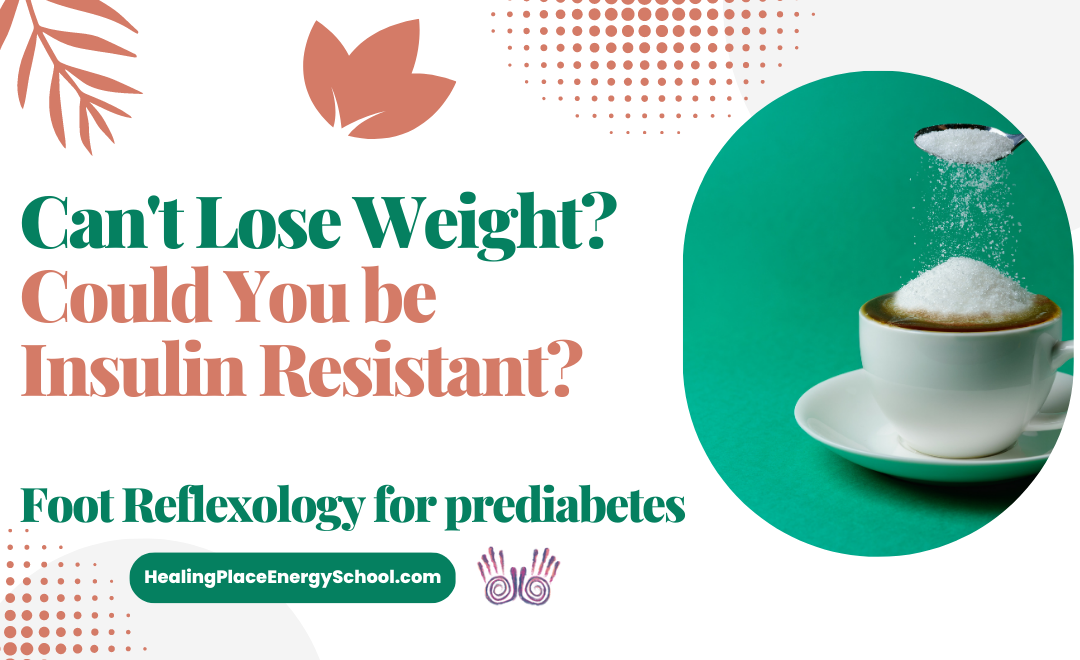If you can’t lose weight and constantly gaining, but your diet has stayed the same? Are you tired all of the time? Are you always looking for something sweet to eat? You might be insulin resistant because your pancreas can no longer produce enough hormones to support digestion. Try Foot Reflexology to support your pancreas functions.
What is Insulin Resistance?
Insulin resistance is when cells become less sensitive to insulin, a hormone that helps regulate blood sugar levels. When cells are insulin resistant, they require more insulin than average to transport glucose (sugar) from the bloodstream into the cells for energy.
What happens next? the pancreas produces more insulin to compensate for the decreased sensitivity of cells to insulin. Over time, the pancreas may become exhausted and unable to produce enough insulin to maintain normal blood sugar levels, leading to prediabetes, type 2 diabetes, and other health problems.
Insulin resistance can also lead to elevated levels of triglyceride fat and cholesterol in the blood, increasing the risk of heart disease and stroke. Other conditions associated with insulin resistance include polycystic ovary syndrome (PCOS), non-alcoholic fatty liver disease (NAFLD), and some forms of cancer.
Being Pre-Diabetic and What Does that Mean?
Prediabetes is when a person’s blood sugar level is higher than usual but not high enough to be considered diabetes. It is a warning sign that indicates an increased risk of developing type 2 diabetes, heart disease, and stroke. Approximately 96 million American adults have prediabetes, and over 80% don’t know they have it.
Millions of people risk developing type 2 diabetes and related health complications without realizing it. Prediabetes often has no symptoms, which makes it difficult to detect without a blood test. Medical guidelines recommend that if you are over 45, overweight, have a family history of diabetes, or have other risk factors for diabetes, get tested for prediabetes annually. Early detection of prediabetes can help people make lifestyle changes to prevent or delay the onset of type 2 diabetes and its associated health complications.
Risk Factors Associated with Insulin Resistance
Risk factors for insulin resistance include being overweight or obese, physical inactivity, a diet high in carbohydrates and sugar, aging, and certain medical conditions such as PCOS and sleep apnea. Treatment for insulin resistance typically involves lifestyle changes such as weight loss, exercise, a healthy diet, and medication in some cases.
Insulin resistance is often asymptomatic in its early stages, which means it may not cause any noticeable symptoms until it has progressed to a more advanced stage.
Who is Likely to Develop Insulin Resistance?
People who have genetic or lifestyle risk factors are more likely to develop insulin resistance or prediabetes. Risk factors include
- overweight or obesity
- age 45 or older
- a parent, brother, or sister with diabetes
- African American, Alaska Native, American Indian, Asian American, Hispanic/Latino, Native Hawaiian, or Pacific Islander American ethnicity
- physical inactivity
- health conditions such as high blood pressure and abnormal cholesterol levels
- a history of gestational diabetes
- a history of heart disease or stroke
- polycystic ovary syndrome, also called PCOS
Insulin Resistance Diagnose Tests
- Fasting blood glucose test: This test measures your blood glucose level after you have fasted for at least eight hours. A glucose level of 100-125 mg/dL indicates prediabetes, while 126 mg/dL or higher indicates diabetes.
- The hemoglobin A1c test measures your average blood glucose level over the past three months. A 5.7-6.4% indicates prediabetes, while 6.5% or higher indicates diabetes.
- The oral glucose tolerance test (OGTT) measures your blood glucose level before and after a sugary drink. A glucose level of 140-199 mg/dL indicates prediabetes, while 200 mg/dL or higher indicates diabetes.
- Insulin resistance test: This test measures your fasting insulin and glucose levels. A high fasting insulin level (more than 25 microU/mL) and a high glucose level (more than 100 mg/dL) indicate insulin resistance.
- Triglyceride-to-HDL ratio: This test measures the percentage of triglycerides to high-density lipoprotein (HDL) cholesterol in your blood. A high percentage (more than 2.0) indicates insulin resistance.
If you are concerned about your risk of insulin resistance or diabetes, talk to your doctor. They can help you determine which tests are appropriate for you and develop a plan for managing your risk.
How Can Reflexology Support Pancreas Functions
Reflexology is a form of alternative medicine that involves applying pressure to specific points on the feet, hands, and ears to stimulate the body’s natural healing processes. Reflexology can help support the function of the pancreas by regulating blood sugar levels.
The pancreas reflex point is located on the inside of both feet, just below the ball of the foot. Applying pressure to these points can help stimulate the flow of energy and blood to the pancreas, which can help improve its function.
Reflexology helps promote relaxation and reduce stress, which is beneficial for overall health, but reflexology is not a substitute for medical treatment.
Find a qualified and certified reflexologist with 200-300 hours of foot reflexology training.
 About the Writer, Teacher, and Film Maker
About the Writer, Teacher, and Film Maker
Helen Chin Lui is a Certified Reflexologist, Certified Energy Medicine, and Reiki Practitioner. She is the owner of the Healing Place LLC and Healing Place Energy School LLC in Medfield, MA. She specializes in helping adults and children to find long-lasting relief from chronic pain, digestive issues, and heal hormonal imbalances naturally.
 Healing Place LLC
Healing Place LLC
Healing Place LLC specializes in helping people of all ages break the pain cycles of chronic pain and chronic digestive problems and balances hormones naturally. If you would like to learn how Reflexology can support your health, please schedule a FREE consultation on the HealingPlaceMedfield.com website or call us (508) 359-6463
 Healing Place Energy School
Healing Place Energy School
Learn more in-depth hand and foot reflexology from the privacy of your home by going to HealingPlaceEnergySchool.com. Become a member as little as $10 a month. We offer Reflexology, chakra, self care, meditation, reiki courses.
Helen Chin Lui’s Books
 If you would like to learn more about personal energy flow, or Reflexology techniques, get copies of Helen’s Books Know Your Chakras: Introduction to Energy Medicine orFoot Reflexology to Promote Relaxation
If you would like to learn more about personal energy flow, or Reflexology techniques, get copies of Helen’s Books Know Your Chakras: Introduction to Energy Medicine orFoot Reflexology to Promote Relaxation


 Healing Place LLC
Healing Place LLC Healing Place Energy School
Healing Place Energy School







 The Healing Place LLC helps all ages to find relief from chronic pain, chronic digestive problems and balance hormones naturally. We practice COVID19 safety. Don’t forget to check on our online school HealingPlaceEnergySchool.com. Thank you.
The Healing Place LLC helps all ages to find relief from chronic pain, chronic digestive problems and balance hormones naturally. We practice COVID19 safety. Don’t forget to check on our online school HealingPlaceEnergySchool.com. Thank you.
Recent Comments